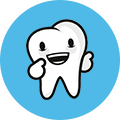
Your teeth can be subjected to digital exams, mainly in the form of X-rays. Two major forms of dental X-rays exist – the intraoral x-rays and the extra-oral x-rays.
Intra-Oral X-Rays: The Types
There are three types of intra-oral x-rays. Each of these types analyzes different aspects of the teeth.
Bite-wing: This examines the lower and upper teeth in just one region of the mouth. A bite-wing x-ray will give the details of a particular tooth starting from the crown to the root. With bite-wing x-rays, the dentist at Mighty Children’s Dentistry, Florida, can detect teeth decay and alterations in the density of the bone usually caused by gingival disease. Bite-wing x-rays also help the dentist to know the right fitting for a cast restoration or a crown.
Periapical X-rays: With a periapical x-ray, details of the entire tooth can be viewed (crown – jaw). With this form of x-ray, Dr Aurelio and his team of specialists can detect root abnormalities and problems with the bone structure that surrounds the tooth.
- Occlusal X-rays: This shows the whole tooth and its placement. Each occlusal x-ray shows the full arch of the dentition in any of the jaws.
Extra-Oral X-Rays: The Types
There are different types of extra-oral x-rays. These include:
Panoramic X-rays: A single panoramic x-ray shows the dentition in both jaws. It is used for detection of emerging or fully emerged teeth. A panoramic x-ray can also detect impacted teeth. It is also important in tumor diagnosis.
Tomograms: This focuses on one layer of the oral cavity (mouth). The rest are blurred out. Tomograms play very vital roles in the examination of dental structures that cannot be clearly seen.
Cephalometric projections: Cephalometric projections help in examination your teeth as it relates to your jaw. It is used by the orthodontists at Parkland, Florida to create their plan of treatment.
Other types of extra-oral x-rays include:
Sialography
Computed tomography
Digital X-Rays: The Current Technology
Digital imaging is the most recent technology. This is different in that it does not involve the development of X-ray films. Rather, the X-rays are transmitted to a computer. You can view it on a monitor, or print it out. Digital x-rays have many benefits:
Very little radiation is used. Also, you don’t have to wait for the film to develop. You can view the images directly on a screen in just some seconds.
Images can be enlarged and enhanced. Your dentist at Mighty Children’s Dentistry, Parkland, Florida, will, therefore, find it easy to reveal the location of the problem and what it is.
Because the images are in digital format, they can be sent via electronic form to a co-dentist for a second opinion on the dental issue.
Computer software assists in the digital comparison of images to others that were previously taken. This process is known as subtraction radiography. With this technique, similar components of both images are deleted, leaving behind only the different portions. This allows the dentist to see those minute differences.

Make an Appointment Today! Our dental team headed by Dr. Aurelio A Bula is ready to put that smile you’ve always wanted on your face.
